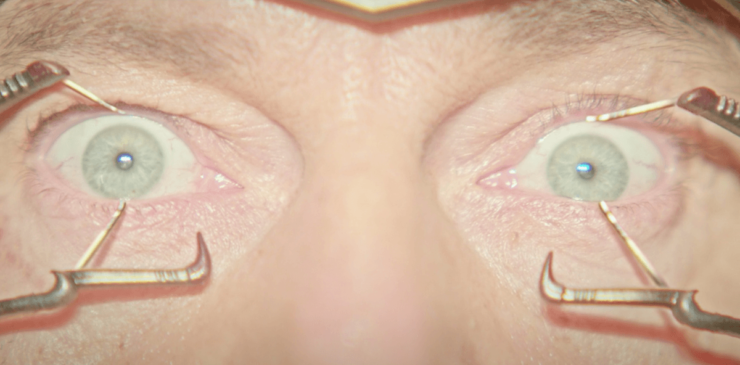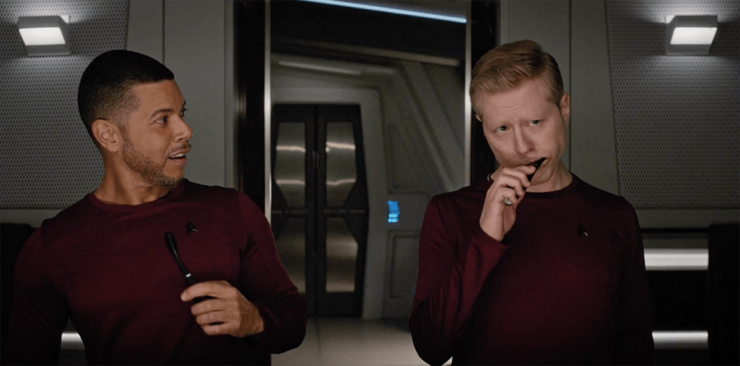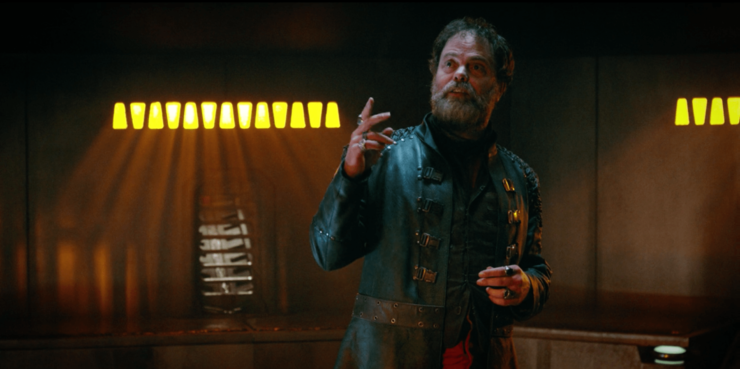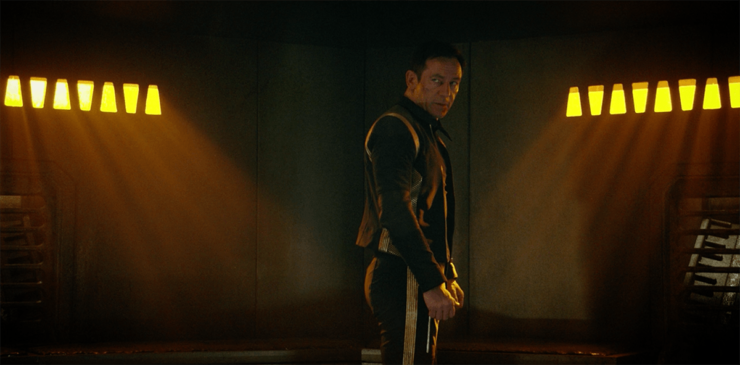In 1966, Star Trek put a black woman and an Asian man on the bridge, and made them senior officers, a year later adding a Russian man to the mix. In an era of civil rights unrest, war in southeast Asia, and the ongoing cold war with the Soviet Union, showing those three working together with the white folks (not to mention the pointy-eared alien) was huge.
In 1993, Star Trek: Deep Space Nine put a black man at the top of the ensemble, and had an Arab doctor. The former was so radical that it had rarely been seen before or since, and the latter is also vanishingly rare.
And now, in 2017, Star Trek Discovery finally gives us a main character on a Trek TV show who is not heterosexual.
It’s kind of appalling that it took until the last year or so for any Trek to acknowledge that there might be homosexuals in the future that aren’t in the Mirror Universe. Stabs were taken at it, particularly on DS9 (“Rejoined,” the aforementioned MU episodes), as well as TNG‘s spectacularly lame-ass attempt to address gender issues in “The Outcast,” but it wasn’t until Star Trek Beyond gave Sulu a husband that we even got a hint of it.
“Choose Your Pain,” however, goes full-tilt boogie, firmly establishing that Stamets is in a long-term, cohabitational relationship with Dr. Hugh Culber (played by Wilson Cruz, so it’s not only a male-male couple, it’s an interracial one!).
This particular lack has been maddening, because Trek has, over the last five decades, been very good about showing that things will be better in the future, at least as long as you’re not gay. Being black doesn’t stop Uhura or La Forge or Sisko or Burnham from becoming officers in Starfleet. Being female doesn’t stop Janeway or Hernandez or Georgiou from being captains (no matter what Janice Lester might think…). We’ve seen interracial couples, interspecies couples, but never same-sex couples.
Until the last couple years, and the first was a blink-and-you’ll-miss-it moment with Sulu (well, two moments—the other was his realization that the Yorktown was the target and he glances at a picture of husband and kid). Now, though, we have an actual honest-to-goodness opening-credits regular who’s not heterosexual. (I hasten to add that this only applies to the screen iterations of Trek. The tie-in fiction has had plenty of different sexualities represented over the years, and it’s way past fucking time that the main canon caught up to the ancillary fiction.)
We don’t actually find that out until the end of the episode, though, and it’s an amusing coda to the public bickering we’ve gotten over two episodes between Stamets and Culber. (It reminds me favorably of the end of the first episode of Hill Street Blues that Frank Furillo and Joyce Davenport, who’ve been at odds in the precinct all episode, are revealed in the last scene to be lovers.)
Apropos of nothing, I also like that Culber isn’t the chief medical officer. Discovery is continuing its pattern of showing us the other guys on the ship, it isn’t just the senior staff. Yes, we’re seeing lots of Lorca and Saru, but our other main characters are the people working on one particular project on the ship (the most important of the 300 or so at the moment, but not the only one). Stamets isn’t the chief engineer, Culber isn’t the CMO, and Tilly’s just a cadet.
Anyhow, what about the episode itself? Parts of it are brilliant, parts of it, not so much.
First of all, we have two direct connections to the greater Star Trek universe, the first being Saru’s asking for a list of great captains and getting April, Archer, Decker, Georgiou, and Pike. (Speaking as someone who wrote an entire novella that had Decker as the main character, I’m loving seeing him there.)
The second, of course, is Rainn Wilson’s superb turn as Harcourt Fenton Mudd. Wilson does an amazing job here, simultaneously channeling Roger C. Carmel but still giving very much a Rainn Wilson performance.
Though this leads me to my biggest problem with the episode, which is Lorca and Tyler (hey, look, Shazad Latif finally showed up after being in the credits for four episodes!) leaving Mudd behind. In a word: no. And again I say: no. Mudd is a Federation citizen. Yes, he sold them out, but that means you bring his ass back to Federation space so he can stand trial. You do not leave him with the enemy. Leaving aside that it makes no sense from a compassionate standpoint (though that’s a big deal when we’re talking Trek), it also makes no sense from a tactical perspective. Even if you accept that Lorca is a dick—which he totally is—there’s still no logic to leaving Mudd behind.
Too many Stupid Television Tricks in this episode. I really want to take every single scriptwriter for TV shows and movies and shake them by the shoulders until they understand that surveillance in prison cells is extremely common. I’ve lost track of the number of times I’ve seen prisoners making plans or having private conversations in prison cells and then either a) being able to fool the bad guys because of the plans they made in the cell or b) being surprised that there’s a listening device and/or one of the prisoners is, in fact, a mole. “Choose Your Pain” gives us b), and it’s idiotic. Hell, the episode that introduced the Klingons established that Klingons themselves are always under surveillance. They wouldn’t need a listening device on Mudd’s pet bug (a bug on a bug!) when they could just put sensors in there, and Lorca should know that.
Also when they escape, why is it Lorca’s so willing to vaporize other Klingons, but only wound L’Rell? Because L’Rell’s a regular, so we can’t kill her! Except plot-wise, that makes no sense.
Speaking of things that make no sense, we have Lorca’s backstory. A captain who killed his entire crew rather than have them fall into Klingon hands—and then he gets a plum assignment with tons of autonomy? That doesn’t track at all. I’m willing to wait and see on that one, because we’re getting a description after the fact. There could be a lot more to that. At least, I hope there is, because if that really is what happened to Lorca at the top of the war, he should at worst be in the cell next to Burnham and at best be at a desk on Earth pushing paper.
Back on the Discovery, though, we get the good stuff. The ongoing dynamic between Burnham and Saru is phenomenal, beautifully played by Sonequa Martin-Green and Doug Jones. I love how Saru is the only person who can break through Burnham’s Vulcan mask, and I like the reveal as to why Saru truly resents Burnham: she denied him the opportunity to be Georgiou’s first officer that she had. Burnham giving Saru the telescope she was willed is a nice touch at the end.
Saru’s methodical approach to being acting captain is fun to see, also, with him calling up the names of great captains and seeing how he compares and where he’s deficient. I also like him deciding not to compile that data at the end, because he knows he made the right decision.
I’m also glad to see that everyone’s realizing that torturing a living being isn’t the ideal way to achieve your nifty-keeno science project. Unfortunately there’s a war on in general and a kidnapped captain in particular, so that has to be put that aside in order to rescue Lorca.
The ending is totally Star Trek. Once Lorca is rescued, Saru knows that they can’t keep torturing a living being (especially one that might be sentient, as Culber informs us), so he all but orders Burnham to set it free (his exact words are to “save its life”), and makes sure to do so before Lorca has been cleared to return to duty, because we all know Lorca won’t give a shit.
Good news: Burnham’s solution of transferring tardigrade DNA to a human seems to work, as Stamets injects himself and uses the spore drive to get them out of enemy territory. Bad news: something seems to be horribly wrong with Stamets, based on the horror-movie moment at the end when his reflection moved at a different speed. Curiouser and curiouser…
Keith R.A. DeCandido is going for his third-degree black belt in Kenshikai karate this week. By the time next week’s Discovery review appears, he hopes to have that third stripe on his belt, assuming all goes well during the three-day promotion process. The appropriate salutation would not be “good luck,” but rather the Japanese phrase, “ganbatte,” which means, “try your best.”














